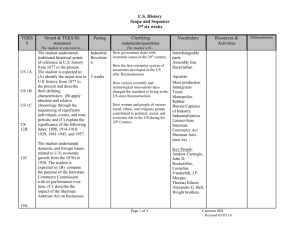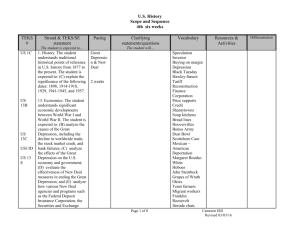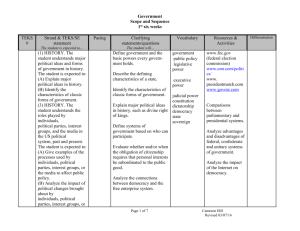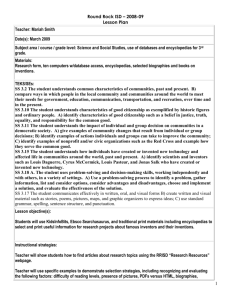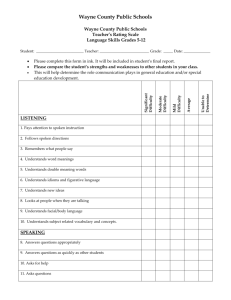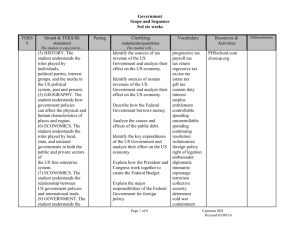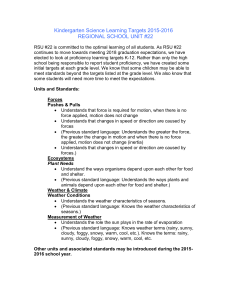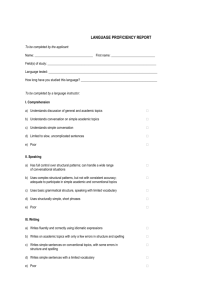The student is expected to…
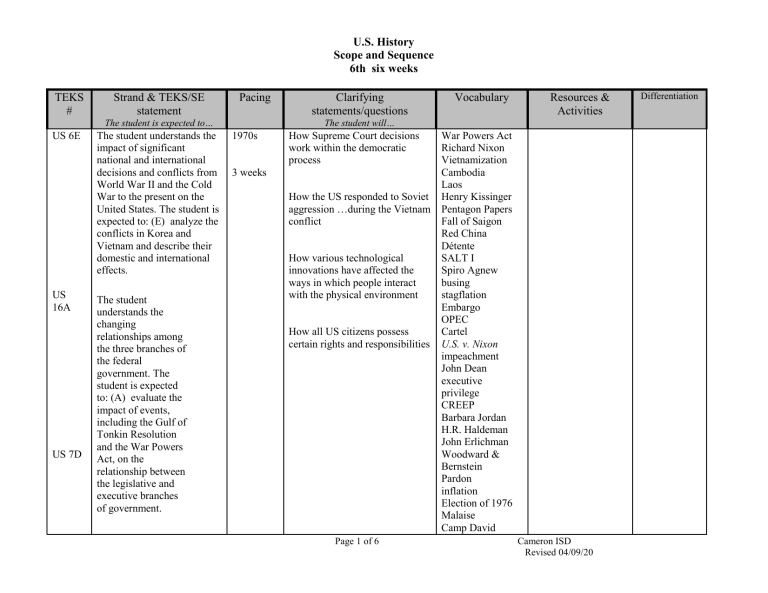
U.S. History
Scope and Sequence
6th six weeks
TEKS
#
US 7D
US
16A
US 6E
Strand & TEKS/SE statement
The student is expected to…
The student understands the impact of significant national and international decisions and conflicts from
World War II and the Cold
War to the present on the
United States. The student is expected to: (E) analyze the conflicts in Korea and
Vietnam and describe their domestic and international effects.
The student understands the changing relationships among the three branches of the federal government. The student is expected to: (A) evaluate the impact of events, including the Gulf of
Tonkin Resolution and the War Powers
Act, on the relationship between the legislative and executive branches of government.
Pacing
1970s
3 weeks
Clarifying statements/questions
The student will…
How Supreme Court decisions work within the democratic process
How the US responded to Soviet aggression …during the Vietnam conflict
How various technological innovations have affected the ways in which people interact with the physical environment
How all US citizens possess certain rights and responsibilities
Page 1 of 6
Vocabulary Resources &
Activities
War Powers Act
Richard Nixon
Vietnamization
Cambodia
Laos
Henry Kissinger
Pentagon Papers
Fall of Saigon
Red China
Détente
SALT I
Spiro Agnew busing stagflation
Embargo
OPEC
Cartel
U.S. v. Nixon impeachment
John Dean executive privilege
CREEP
Barbara Jordan
H.R. Haldeman
John Erlichman
Woodward &
Bernstein
Pardon inflation
Election of 1976
Malaise
Camp David
Cameron ISD
Revised 04/09/20
Differentiation
US
US
15C
US 14
E
17A
The student understands the impact of the
American civil rights movement.
The student is expected to:
(D) identify changes in the
United States that have resulted from the civil rights movement such as increased participation of minorities in the political process.
The student understands the economic effects of
World War II, the
Cold War, and increased worldwide competition on contemporary society. The student is expected to:
(E) describe the dynamic relationship between U.S. international trade policies and the U.S. free enterprise system.
U.S. History
Scope and Sequence
6th six weeks
Accords
Panama Canal
Soviet invasion of
Afghanistan
EPA
Three-Mile Island
Love Canal
Shah of Iran
Ayatollah
Khomeini
Flower power
Disco
ERA
Women’s
Movement
Muhammad Ali
Stephen Spielberg
George Lucas
Roots
Earth Day
Regents…v. Bakke
Roe v. Wade
Page 2 of 6 Cameron ISD
Revised 04/09/20
21C
US 20E
US
US
20D
US
21D
The student understands changes in the role of government over time. The student is expected to:
(C) evaluate the effects of political incidents such as
Teapot Dome and
Watergate on the views of U.S. citizens concerning the role of the federal government
The student understands the impact of constitutional issues on American society in the 20th century.
The student is expected to:
(A) analyze the effects of 20thcentury landmark
U.S. Supreme Court decisions such as
Brown v. Board of
Education, Regents of the University of
California v. Bakke , and Reynolds v.
Sims
U.S. History
Scope and Sequence
6th six weeks
Page 3 of 6 Cameron ISD
Revised 04/09/20
US 23
A
The student understands the relationship between the arts and the times during which they were created. The student is expected to:
(D) analyze the relationship between culture and the economy and identify examples such as the impact of the entertainment industry on the U.S. economy; and
(E) identify the impact of popular American culture on the rest of the world.
The student understands how people from various groups, including racial, ethnic, and religious groups, adapt to life in the United States and contribute to our national identity. The student is expected to: (C) analyze how the contributions of people of various racial, ethnic, and religious groups have helped to shape the national identity; and
(D) identify the political, social, and economic contributions of women to
American society.
The student understands the influence of scientific discoveries and
1980s
U.S. History
Scope and Sequence
6th six weeks
Page 4 of 6
Reaganomics conservatism
Religious Right
Cameron ISD
Revised 04/09/20
US
20D
US 20E
US 6 G
US 22
A technological innovations on daily life in the United
States. The student is expected to: (A) analyze how scientific discoveries and technological innovations, including those in transportation and communication, have changed the standard of living in the United States.
The student understands the impact of significant national and international decisions and conflicts from
World War II and the Cold
War to the present on the
United States. The student is expected to: (G) analyze reasons for the Western victory in the Cold War and the challenges of changing relationships among nations.
The student understands the relationship between the arts and the times during which they were created. The student is expected to:
(D) analyze the relationship between culture and the economy and identify examples such as the impact of the entertainment industry
3 weeks
U.S. History
Scope and Sequence
6th six weeks
Deregulation
Sandra Day
O’Conner
Iran-Contra
Elections of
1980,1984, 1988
George Bush
Grenada
Star Wars
“Evil Empire”
Arms Race
Lebanon
Central America
Mikhail
Gorbachev
Berlin Wall perestroika glasnost
Tiananmen
Square, 1989
START
MTV
AIDS
Challenge
Jesse Jackson personal computers
Page 5 of 6 Cameron ISD
Revised 04/09/20
on the U.S. economy; and
(E) identify the impact of popular American culture on the rest of the world.
The student understands the impact of science and technology on the economic development of the United
States. The student is expected to: (A) explain the effects of scientific discoveries and technological innovations such as electric power, the telegraph and telephone, petroleum-based products, medical vaccinations, and computers on the development of the United
States
U.S. History
Scope and Sequence
6th six weeks
Page 6 of 6 Cameron ISD
Revised 04/09/20
